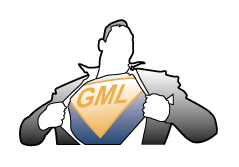1.2.5. Geography Markup Language
Geography Markup Language (GML) is an XML encoding for the transport and storage of geographic information, including both the geometry and properties of geographic features. It is an open data exchange standard well-suited for transmitting small to medium-sized volumes of information. GML is usable with all standard XML tools. (Reichhardt 2003)
GML was defined to (Reichhardt 2003):
|
 GML is great! (Geoconnections.org) GML is great! (Geoconnections.org) |
"A GML document is an XML-encoded text file and by itself, does not "do" anything." (Geoconnections.org)
Why should I use GML?
According to (Geoconnections.org) there are five main reasons why to use GML:
- GML is an OGC and ISO standard for encoding geographic objects. As such, many vendors have already created products to produce or consume GML, and are more likely to do so. Since it has been extensively reviewed, GML is more likely to be complete and error-free than other methods of encoding geographic objects.
- Since it is XML based, it is Web-compatible, and inherits from XML all the tools and methods that work on XML schemas and instances.
- It is object-based, so everything you need to know about a geographic highway (e.g. a piece of highway) can be encoded in a single object without having to look up other pieces of information.
- It is modular so that you can encode a single object, or a large set of features corresponding to an entire map sheet with many layers (with various levels of complexity in between).
- GML is mandated by and embedded in other OGC specifications, namely web feature services and filter encoding.
The following image shows an extract of a GML file:
 Extract of a GML file
Extract of a GML fileIf you are interested in details about GML have a look at the GML Specification (PDF). Be aware that this specification is neither a quick nor a simple read and you need a basic understanding of XML.
